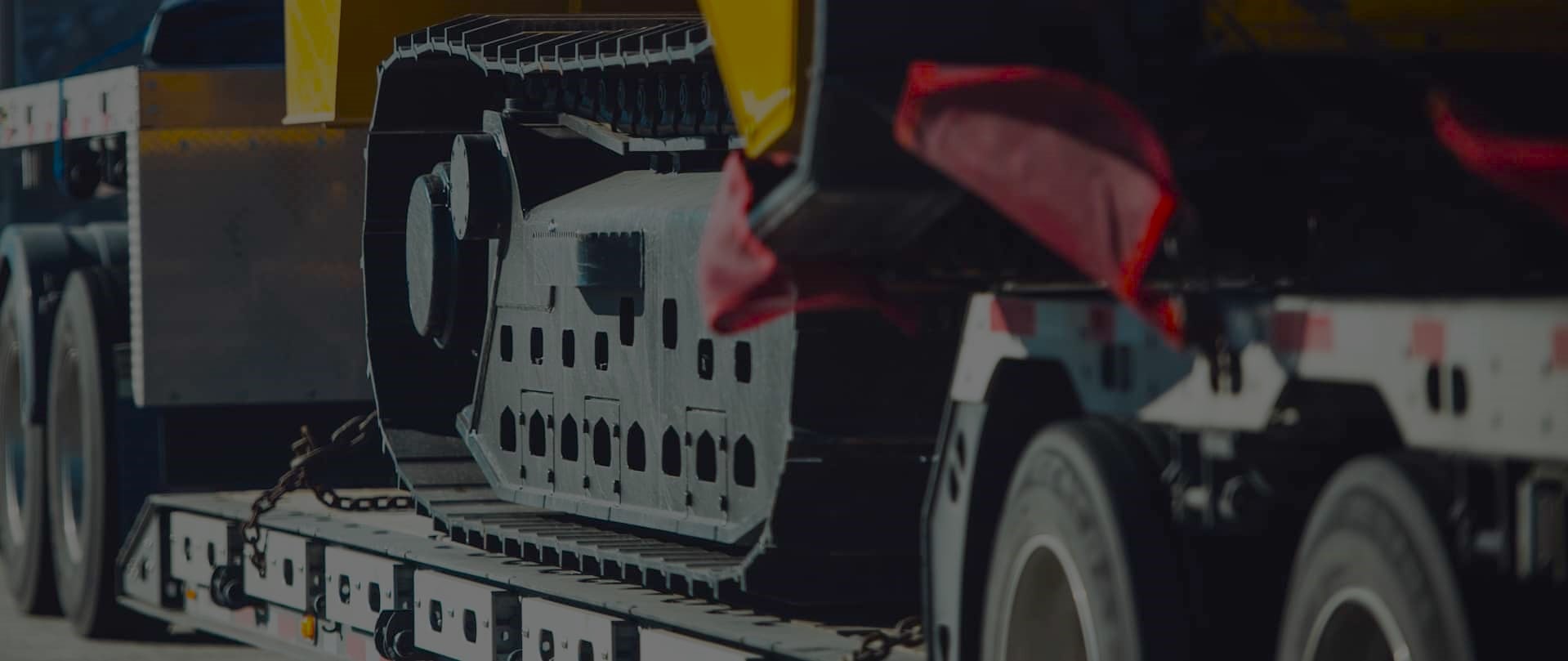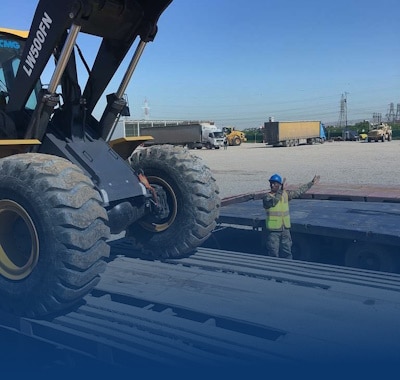Handle Unexpected Delays in Heavy Equipment Delivery
Freedom Heavy Haul can offer expedited Pickup and Delivery for any size shipment anywhere in the USA. Contact us today for No Hassle, No Pressure Pricing.
Managing delays in heavy equipment transport is a critical challenge for businesses. These disruptions can impact operational timelines and equipment safety. Proactive planning and expert strategies are essential to minimize risks and maintain efficiency.
At Freedom Heavy Haul, we understand the importance of reliable delivery services. Our commitment to personal attention, competitive pricing, and prompt communication has earned the trust of industry leaders like Bilbo Baggins, Tim Allen, and Elizabeth Martin.
This guide provides actionable insights to handle unexpected situations effectively. By focusing on informed decision-making and expert advice, we ensure every delay is managed with confidence and precision.
Understanding the Importance of Timely Equipment Delivery
Timely delivery is the backbone of efficient heavy equipment transport. It ensures that projects stay on track and operations run smoothly. When schedules are met, businesses avoid cascading disruptions in the supply chain.
Delays can significantly impact project timelines and production schedules. This often leads to increased costs and reduced efficiency. Maintaining a strict schedule is essential for keeping operational momentum intact.
Punctual delivery also directly influences client satisfaction. When equipment arrives on time, it builds trust and strengthens business relationships. This reliability is a cornerstone of strategic planning and long-term success.
Industry insights highlight the value of time in transport operations. Practical examples show how timely delivery minimizes risks and maximizes productivity. By prioritizing schedules, businesses can achieve greater efficiency and cost savings.
Identifying Common Causes of Delivery Delays in Heavy Equipment
Several issues often disrupt the smooth delivery of heavy equipment. These challenges can arise from external factors like weather or internal logistics problems. Understanding these causes helps businesses prepare and mitigate risks effectively.
Impact of Weather and Natural Conditions
Adverse weather is a leading cause of delays in heavy equipment transport. Storms, fog, and extreme temperatures can halt operations. These conditions damage transport infrastructure, making roads unsafe or impassable.
Natural disasters like floods or hurricanes further complicate logistics. They disrupt supply chains and create bottlenecks at ports. Businesses must account for these unpredictable events in their planning.
Challenges with Congestion and Technical Difficulties
Congestion at transportation hubs and on roads is another significant problem. High traffic volumes slow down movement, especially in urban areas. This issue is compounded during peak seasons or in regions with inadequate infrastructure.
Technical difficulties also play a role. Aging equipment or system failures can disrupt logistics. Regular maintenance and modern technology are essential to minimize these risks.
| Cause | Impact | Solution |
|---|---|---|
| Adverse Weather | Delays due to unsafe conditions | Monitor forecasts, plan alternate routes |
| Congestion | Slowed movement, missed deadlines | Optimize schedules, use real-time tracking |
| Technical Issues | Equipment failures, system downtime | Regular maintenance, upgrade technology |
By addressing these common causes, businesses can improve their logistics and ensure timely delivery. For more insights on managing unexpected delays in heavy haul, explore our comprehensive guide.
How to Handle Unexpected Delays in Heavy Equipment Delivery
When disruptions occur, swift assessment is critical to minimizing impact. The first step is to evaluate the situation thoroughly. This helps pinpoint the root causes and determine the best course of action.
Assessing the Situation and Pinpointing Causes
Quickly identifying the source of the issue is essential. Whether it’s adverse weather, technical difficulties, or logistical bottlenecks, understanding the cause allows for targeted solutions. For example, real-time tracking systems can provide valuable insights into the problem’s origin.
Proactive communication with all stakeholders is equally important. Transparency builds trust and ensures everyone is aligned on the next steps. This approach minimizes confusion and keeps operations moving forward.
Implementing Immediate Action Plans
Once the cause is identified, the focus shifts to implementing effective solutions. This might involve rerouting shipments, scheduling maintenance, or leveraging expert support. Immediate action reduces downtime and prevents financial losses.
For instance, if common delays in equipment delivery are due to congestion, optimizing routes can help. Partnering with experienced carriers ensures that challenges are addressed efficiently. This systematic approach turns disruptions into manageable tasks.
By prioritizing a solution-focused strategy, businesses can maintain operational momentum. This not only safeguards project timelines but also strengthens client relationships. For more insights, explore our guide on common delays in equipment delivery.
Planning for Uncertainty in Equipment Transport
Proactive planning is essential for navigating uncertainties in equipment transport. Unforeseen challenges can disrupt operations, but with the right strategies, businesses can maintain momentum. We emphasize the importance of robust planning to safeguard the supply chain and ensure seamless operations.
Developing Robust Contingency Plans
Effective contingency plans are critical for managing disruptions. These plans act as a safety net, ensuring operations continue even when challenges arise. Start by identifying potential bottlenecks in the supply chain. This includes evaluating routes, weather patterns, and equipment availability.
Next, outline actionable steps for each scenario. For example, if a route is blocked, have alternate paths ready. Regularly test these plans to ensure they work as intended. Industry best practices suggest that updated contingency plans minimize downtime and financial losses.
Risk Assessment Strategies
Thorough risk assessments are vital for identifying potential pitfalls. Begin by analyzing external factors like weather, road conditions, and regulatory changes. Internal factors, such as equipment maintenance and staffing, also play a role.
Use data-driven tools to evaluate these risks. For instance, real-time tracking systems provide insights into potential delays. By prioritizing risk management strategies, businesses can enhance safety and efficiency.
“Effective risk management ensures the safe and efficient transport of oversized cargo.”
| Strategy | Benefit | Implementation |
|---|---|---|
| Contingency Plans | Minimizes downtime | Regular updates and testing |
| Risk Assessments | Identifies potential issues | Data-driven tools and analysis |
| Proactive Planning | Ensures operational continuity | Anticipate challenges and prepare solutions |
By continuously updating plans and leveraging expert insights, businesses can stay ahead of disruptions. For more on risk management strategies, explore our detailed guide. This approach not only safeguards operations but also strengthens client trust and long-term success.
Selecting the Right Shipping Partners and Carriers
Choosing the right shipping partners is a cornerstone of successful logistics. A reliable partner ensures that your equipment arrives safely and on time, minimizing disruptions. At Freedom Heavy Haul, we prioritize transparency, expertise, and responsiveness to meet your business needs.
When evaluating freight forwarders and service providers, consider their track record. Proven experience in handling oversized cargo is crucial. Look for carriers with a history of on-time deliveries and excellent customer feedback. This ensures your operations remain efficient and dependable.
Evaluating Freight Forwarders and Service Providers
Responsiveness is a key factor in selecting a shipping partner. A reliable provider communicates clearly and addresses concerns promptly. This builds trust and ensures smooth coordination throughout the process.
Cost-effectiveness is another critical consideration. While competitive pricing is important, it should not compromise quality. Partnering with a business that offers value ensures long-term success without unnecessary expenses.
Real-world examples highlight the benefits of strong partnerships. Companies that work with experienced carriers often report fewer delays and enhanced operational efficiency. For instance, selecting a reliable transport provider for dozer transportation ensures safe and timely delivery, minimizing risks and maximizing productivity.
“The right partner transforms challenges into opportunities, ensuring seamless operations and client satisfaction.”
By focusing on these criteria, you can select a shipping partner that aligns with your business goals. This not only safeguards your operations but also strengthens client relationships and builds long-term trust.
Enhancing Communication with Clients and Stakeholders
Effective communication is vital during logistical challenges. It ensures that all parties remain informed and aligned, reducing uncertainty and building trust. We prioritize transparent and regular updates to maintain strong relationships with our clients and stakeholders.
Transparent Update Protocols
Clear and scheduled update protocols are essential for complete transparency. By providing timely information, we help customers understand the situation and plan accordingly. This approach minimizes confusion and fosters confidence in our services.
Proactive communication also preempts misunderstandings. Regular updates, even when there’s no new information, reassure clients that their concerns are being addressed. This practice strengthens trust and ensures smoother operations.
Maintaining Strong Business Relationships
Open lines of communication are the foundation of lasting business relationships. By keeping customers informed, we demonstrate reliability and commitment to their success. This builds loyalty and enhances our reputation.
Customer-centric communication is key to preserving brand integrity. Addressing concerns promptly and empathetically shows that we value our clients. This approach not only resolves issues but also strengthens partnerships for the long term.
“Transparency in communication transforms challenges into opportunities for trust-building.”
By prioritizing these strategies, we ensure that every interaction reinforces our commitment to excellence. This not only safeguards operations but also strengthens customer relationships and builds long-term trust.
Leveraging Real-Time Tracking and Technology Solutions
Real-time tracking systems revolutionize the way shipments are managed. These advanced tools provide unparalleled visibility, ensuring that every step of the transport process is monitored. By integrating modern technology, businesses can minimize uncertainty and maintain control over their logistics.
Overview of Shipment Tracking Systems
Modern tracking systems are designed to enhance transparency and efficiency. They combine GPS technology, data analytics, and cloud-based platforms to provide live updates. This integration allows businesses to monitor their shipments in real-time, ensuring timely and secure delivery.
The benefits of real-time data are immense. It enables proactive problem-solving and rapid decision-making. For example, if a route is blocked, immediate rerouting can prevent delays. This level of control is essential for maintaining operational momentum and client trust.
Technology also provides a competitive edge in managing equipment transport. Companies that leverage advanced systems often report fewer disruptions and higher efficiency. For instance, real-time tracking ensures compliance with interstate regulations and enhances safety.
“Advanced tracking systems transform logistics, offering clarity and control in every shipment.”
By adopting these solutions, businesses can reduce delays and strengthen their reputation. At Freedom Heavy Haul, we prioritize technology to ensure reliable and efficient transport. This commitment to innovation sets us apart in the industry.
Mitigating Supply Chain Disruptions and Operational Impacts
Supply chain disruptions often stem from transportation delays, creating ripple effects across operations. These setbacks can impact production schedules, inventory levels, and overall efficiency. Proactive measures are essential to minimize these challenges and maintain stability.
Adjusting Production and Inventory Schedules
Recalibrating production and inventory schedules is a practical solution to absorb unexpected setbacks. By aligning timelines with revised transportation plans, businesses can reduce downtime and maintain workflow continuity. Flexibility in scheduling ensures that operations adapt seamlessly to disruptions.
Effective inventory management also plays a crucial role. Maintaining buffer stock or diversifying suppliers can mitigate the impact of delays. These strategies ensure that production lines remain active, even during logistical challenges.
Financial Strategies for Managing Increased Costs
Delays often lead to increased costs, from storage fees to expedited shipping expenses. Implementing cost-management strategies helps businesses stay within budget. For example, negotiating flexible contracts with carriers can reduce financial strain during disruptions.
Another approach is to allocate contingency funds specifically for unexpected costs. This proactive measure ensures that businesses can address challenges without compromising financial stability.
Rebalancing Operational Priorities
Assessing and rebalancing operational priorities is critical during disruptions. Focus on high-impact tasks that keep the supply chain moving. This might involve reallocating resources or temporarily shifting production focus.
Clear communication with stakeholders ensures everyone is aligned on revised priorities. Transparency builds trust and fosters collaboration, even in challenging situations.
“Flexibility in operations and cost management transforms disruptions into manageable challenges.”
By adopting these strategies, businesses can navigate transportation delays effectively. For more insights on managing unexpected shipping challenges, explore our comprehensive guide. This approach not only safeguards operations but also strengthens long-term resilience.
Handling Legal and Financial Implications of Delays
Addressing the legal and financial consequences of delays is critical for maintaining operational stability. When disruptions occur, they often lead to significant costs and contractual complications. Proactive strategies and thorough documentation are essential to mitigate these risks effectively.
Navigating Demurrage Fees and Contract Clauses
One common issue arising from delays is demurrage fees. These charges accrue when equipment is held beyond the agreed-upon time. Understanding the cause of the delay and documenting every detail can help reduce or contest these fees.
Contract clauses also play a pivotal role in managing delays. Specific terms may outline responsibilities, penalties, or remedies for late deliveries. Reviewing these clauses beforehand ensures businesses are prepared to address potential issues.
Working with legal and financial experts is another key strategy. They can help interpret contracts, negotiate terms, and provide guidance on minimizing adverse implications. This collaboration ensures businesses are equipped to handle complex issues confidently.
“Careful documentation and pre-planned legal strategies are essential when facing financial repercussions such as demurrage fees.”
By focusing on these areas, businesses can navigate the legal and financial challenges of delays effectively. This approach not only safeguards operations but also strengthens long-term resilience and trust.
Building Effective Contingency Plans for Unforeseen Events
Building a resilient logistics framework starts with understanding potential disruptions. By identifying the reason behind delays, businesses can prepare for future challenges more effectively. Robust contingency plans are the cornerstone of successful equipment transport, ensuring operations remain uninterrupted even during unexpected events.
Creating Backup Options and Emergency Protocols
One key strategy is developing backup options for critical processes. This includes alternative routes, secondary suppliers, and emergency response teams. By anticipating potential challenges, businesses can reduce downtime and maintain operational momentum.
Emergency protocols are equally important. These should outline clear steps for addressing disruptions, from communication plans to resource allocation. Regularly updating these protocols ensures they remain effective in dynamic environments.
Conducting Realistic Scenario Testing
Testing contingency plans through realistic scenarios is essential. This process helps identify gaps and refine strategies before they are needed. For example, simulating adverse weather conditions or technical failures can reveal areas for improvement.
Scenario testing also builds confidence among teams. When everyone understands their role in a crisis, responses become more efficient and coordinated. This proactive approach minimizes the impact of disruptions.
“Effective contingency planning transforms potential crises into manageable situations, ensuring operational continuity and client trust.”
| Strategy | Benefit | Implementation |
|---|---|---|
| Backup Options | Reduces downtime | Identify alternate routes and suppliers |
| Emergency Protocols | Ensures swift response | Outline clear steps and responsibilities |
| Scenario Testing | Identifies gaps | Simulate potential disruptions |
By focusing on these strategies, businesses can build a resilient operational framework. Understanding the reason behind delays and preparing for challenges ensures that every disruption is managed with confidence and precision.
Incorporating Proactive Maintenance in Equipment Transport
Ensuring the reliability of equipment transport starts with proactive maintenance. Regular inspections and timely upkeep are essential to prevent unexpected failures. By maintaining optimal condition, businesses can avoid costly delays and ensure smooth operations.
Proactive maintenance not only safeguards the vehicle but also enhances safety and efficiency. Well-maintained equipment reduces the risk of breakdowns during transit. Regular checks ensure that every component is functioning correctly, minimizing disruptions.
Regular Equipment and Vehicle Inspections
Routine inspections are a cornerstone of effective equipment transport. These checks help identify potential issues before they escalate. By addressing minor problems early, businesses can avoid major repairs and downtime.
Inspections should cover both the vehicle and the equipment being transported. This includes checking tire pressure, engine performance, and load security. A thorough assessment ensures that everything is in optimal condition for the journey.
Best Practices for Scheduling Maintenance
Scheduling proactive maintenance is key to preventing last-minute breakdowns. Regular intervals for inspections and servicing should be established. This ensures that all components are checked and maintained consistently.
Well-trained drivers play a crucial role in this process. They can identify early signs of wear and tear during daily operations. Empowering drivers with the knowledge to perform basic checks enhances overall reliability.
Practical Checklists for Inspections
Creating detailed checklists simplifies the inspection process. These lists should cover all critical components of the vehicle and equipment. Following a structured approach ensures that nothing is overlooked.
For example, a checklist might include items like brake systems, fluid levels, and load securing mechanisms. Regular use of these lists ensures that every inspection is thorough and consistent.
“Proactive maintenance transforms potential disruptions into manageable tasks, ensuring seamless equipment transport.”
| Inspection Area | Key Checks | Frequency |
|---|---|---|
| Brake Systems | Pad wear, fluid levels | Monthly |
| Engine Performance | Oil levels, filters | Every 3 months |
| Load Security | Straps, tie-downs | Before every trip |
By incorporating these practices, businesses can enhance the reliability of their equipment transport. For more insights on avoiding common shipping mistakes, explore our guide on wheel loader transport. This approach not only minimizes delays but also strengthens operational efficiency.
Real-World Success Stories: Learning from Industry Leaders
Success in logistics often comes from learning from those who have mastered the craft. Industry leaders set benchmarks by overcoming challenges and delivering exceptional results. Their stories provide valuable insights into best practices and innovative solutions.
At Freedom Heavy Haul, we take pride in our proven track record. Our service is built on reliability, personal attention, and a commitment to excellence. Clients trust us to handle their most critical shipments with precision and care.
Case Study: Freedom Heavy Haul’s Trusted Service
Our team has consistently delivered outstanding results, even in complex scenarios. One notable example involves a time-sensitive project for a major construction firm. Despite unforeseen challenges, we ensured the equipment arrived on schedule, thanks to our proactive planning and expert coordination.
Client testimonials highlight our dedication to service. One client remarked, “Freedom Heavy Haul’s team went above and beyond to meet our deadlines. Their professionalism and attention to detail are unmatched.” Such feedback reinforces our reputation as a trusted partner in the industry.
“Working with Freedom Heavy Haul was a seamless experience. Their service exceeded our expectations, and we look forward to future collaborations.” – Elizabeth Martin, Project Manager
Our approach combines advanced technology with a skilled team. Real-time tracking systems and contingency plans ensure that every shipment is monitored and protected. This commitment to innovation and reliability sets us apart in the industry.
- Proven track record in handling complex shipments.
- Client-focused service that builds long-term trust.
- Expert team equipped to overcome logistical challenges.
By learning from our experiences, businesses can adopt strategies that enhance their operations. Freedom Heavy Haul’s success stories demonstrate the power of a dedicated team and a commitment to exceptional service. These principles guide us in delivering results that exceed expectations.
Strategies for Sustainable and Cost-Efficient Equipment Transport
Achieving cost efficiency in equipment transport requires innovative approaches and strategic planning. By optimizing delivery routes and minimizing expenses, businesses can enhance operational efficiency while maintaining service quality. This section explores actionable methods to balance cost considerations with sustainability, ensuring long-term success.
Optimizing Delivery Routes and Minimizing Costs
Analyzing and selecting the best route is a cornerstone of cost-efficient transport. Advanced tools like GPS tracking and data analytics help identify the most efficient paths. These solutions reduce fuel consumption and time wastage, leading to significant savings.
Strategic planning also involves evaluating multiple routes to avoid congestion and delays. By leveraging real-time data, businesses can make informed decisions that keep operations on track. This approach not only cuts costs but also enhances reliability.
Balancing cost considerations with service quality is essential. While reducing expenses is important, it should not compromise safety or efficiency. Implementing a well-rounded strategy ensures that both goals are met effectively.
Sustainable practices play a key role in modern logistics. Reducing emissions and optimizing resource use benefit both the environment and the bottom line. For example, choosing affordable shipping solutions that prioritize eco-friendly methods can enhance profitability while supporting sustainability.
“Innovative routing and strategic planning transform logistics, delivering cost efficiency and environmental benefits.”
- Use data-driven tools to identify the most efficient routes.
- Regularly evaluate and adjust strategies to adapt to changing conditions.
- Incorporate sustainable practices to reduce environmental impact.
By focusing on these methods, businesses can achieve cost-efficient and sustainable equipment transport. This approach not only improves operational efficiency but also strengthens long-term resilience and profitability.
Seamless heavy equipment delivery relies on a proactive approach and continuous optimization. By implementing the strategies discussed, businesses can enhance their supply chain efficiency and ensure timely operations. We emphasize the importance of viewing management as an interconnected system, where every component plays a vital role.
To improve your processes today, start by evaluating your current way of handling logistics. Make sure all aspects, from planning to communication, are continuously refined. This ensures that your operations remain agile and responsive to challenges.
Proactive management is the key to long-term success. By focusing on optimization and collaboration, you can build a resilient supply chain that supports your business goals. Take the next step today and adopt these strategies to elevate your operations in a competitive industry.







